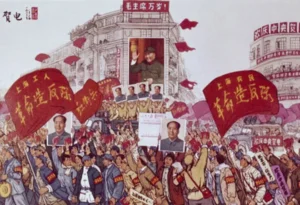A Climate Perspective: Europe’s De-risking Strategy in Anticipation of a Taiwan Crisis
Taiwan is a geographically small yet integral cog in the world’s low-carbon transition. It enjoys the benefits of what is often referred to as the “silicon shield,” boasting a near monopoly in semiconductor production accounting for 92% of the world’s most advanced logic chips and nearly half of less sophisticated chips that are crucial for emerging green technologies.

Image Credit: Shutterstock
Geopolitical conflicts, from World War II to the 1973 Arab-Israeli War, have always affected energy supplies, natural resource markets, and supply chain stability. While contemporary conflicts follow the same trend, they now pose a new challenge to the realm of climate policy: the green transition, spearheaded notably by Europe. This transformation can be attributed not only to Russia’s war on Ukraine but also to the growing efforts across the Atlantic to de-risk.
With ongoing discussions, both overt and covert, regarding potential conflicts involving China and the greater Indo-Pacific region, it is imperative for Europe to pre-emptively consider and take action to secure the green transition against possible conflict — whether militarily or otherwise — in China’s neighborhood.
Russia’s invasion of Ukraine had both adverse and favorable outcomes for the sustainability agenda. In the former instance, the world witnessed a surge in energy prices and diversification to other authoritarian states, particularly those in the MENA (Middle East and North Africa) region. In the case of the latter, ambitious action plans superseded previous goals, propelling the development of a green hydrogen economy. Suddenly, the International Energy Agency’s forecasted global clean energy investment was well on track to reach “more than $2 trillion a year by 2030.”
Climate policy has now become a pivotal axis of geopolitical maneuvering. Key documents such as the European Economic Security Strategy and the first-of-its-kind German National Security Strategy succinctly illustrate the importance of sustainability in national, regional, and international security contexts. Meanwhile, the rapid roll-out of instruments like the Inflation Reduction Act in the United States and the REPowerEU plan in Europe exemplify policymakers’ decisive and forward-thinking actions.
China has ascended to the global pinnacle as the foremost producer of numerous essential raw materials and their associated components and products. This commanding position at the helm of these supply chains, which includes the dominance of 30 critical minerals, along with its prowess in research and development, has made Europe increasingly reliant on Beijing. As of May 2023, 98% of the European Union’s rare earth materials were imported from China. This significance extends to the realm of emerging technology, as Beijing is now bankrolling green energy projects domestically and overseas via batteries, solar panels, wind turbines, carbon capture, and energy storage.
This multifaceted achievement results from initial investments first made in the late 2000s and a sustained endeavor to continue “cornering” such supply chains. In July this year, China solidified its monopoly by introducing restrictions on gallium and germanium, both of which are vital for chip manufacturing. Companies are now required to obtain special licenses to export these materials outside of China, reaffirming their control of the industry.
Taiwan, meanwhile, is a geographically small yet integral cog in the world’s low-carbon transition. It enjoys the benefits of what is often referred to as the “silicon shield,” boasting a near monopoly in semiconductor production accounting for 92% of the world’s most advanced logic chips and nearly half of less sophisticated chips that are crucial for emerging green technologies.
In the most extreme scenario of a military invasion, a rough estimate suggests a potential annual loss of $1.6 trillion in Taiwanese revenue, not to mention the complete destruction of chipmaking facilities. Adding to this complexity, the Taiwan Strait stands as “one of the world’s busiest shipping arteries,” with almost half of the global container fleets passing through it each year. Any sanctions imposed on China, which would be the most likely response by the G7 and its allies, would spell chaos for global supply chains. This kind of disruption would affect the green transition and extend to essential sectors such as medical devices, telecommunications, and agriculture.
While effects would be deleterious globally, the Indo-Pacific neighborhood — including more developed countries like Japan and South Korea — would suffer particularly as proximate supply routes get cut and the US and its allies look elsewhere.
Europe has already taken some action to reduce its dependencies. The Dutch company ASML is now the only manufacturer in the world equipped with extreme UV light technology — a necessary component for high-end chip technology — outside of Taiwan. Simultaneously, Germany’s partnership with Intel involves a substantial €33 billion investment in a chip manufacturing site, aligning with Europe’s goals to double the bloc’s share of global chip output to 20% by 2030, in accordance with the EU Chips Act.
However, a more unified and determined approach is needed.
For instance, while the EU Green Deal showcases its potential, strengthening its external strategy is imperative. Resistance to the carbon border adjustment mechanism (CBAM) is just one example of its weaknesses. Implementing more centralized and concentrated institutions, such as the proposed European energy agency, or tapping into regional resources, like Sweden’s recently discovered rare earth deposit, can expedite progress, even though these measures may not be fully operational for several years.
Expanding beyond the region, fostering cooperation with less-developed economies is poised to play an important role. This approach not only demonstrates to customers and investors that European companies are committed to sustainability, but it also stimulates greater demand within Europe, all the while stymieing these resource-rich countries from turning even further to China.
Take Vietnam, for instance. As it positions itself as the second-largest producer of rare earths globally, following China, the European Union has already successfully negotiated a free trade agreement.
Simultaneously, delivering on EU Global Gateway promises for infrastructure investment such as those of electricity grids, using frameworks such as the Just Transition Mechanism for equitable finance commitments, and proceeding with joint co-innovation and research as through the current development program NDICI- Global Europe can help gain trust. Leveraging forums like the EU Science Hub and multilateral institutions like the CTCN will meanwhile promote and accelerate technology transfer.
Beyond safeguarding our global environment, these actions also align with Europe’s economic and security interests. Furthermore, even in the absence of conflicts in the vicinity of China, these measures will remain pivotal for Europe’s long-term geopolitical heft, regional security, and economic autonomy.
As Europe, spearheaded by France, intensifies its strategic engagement in the Indo-Pacific, it becomes more and more pressing to delineate clearer boundaries with Beijing. At the same time, bolstering collaboration with Asian partners within established European frameworks such as the Kiwa Initiative or the Global Gateway Initiative will propel European sustainability efforts forward.
The recent US-Japan-ROK Summit at Camp David highlights this momentum, offering Europe a timely reminder and an opportunity to demonstrate boldness. Initiatives such as the Minerals Security Partnership or Supply Chain Early Warning System (EWS) Pilot emphasize the necessity of fortifying global green resilience and preparing for prolonged great power competition, whether in the Indo-Pacific or beyond.

Leonie Müller is a second-year MA student in NYU’s International Relations department. She earned a BSc in Psychology from Durham University, UK, with a focus on socio-political psychology. Originally from Germany, she grew up in Manila, Tokyo, and Beijing. Her professional background is in the think tank world, where she most recently served as a Young Global Professional at the Atlantic Council’s Europe Center in Washington, DC, and previously interned at the European Council on Foreign Relations in Berlin, Germany. Before that, Leonie worked at Deutsche Bank. Her academic and professional interests revolve around great power competition, emerging technology, and geopolitical risk. In her free time, Leonie enthusiastically explores all that New York has to offer and enjoys outdoor activities such as hiking, swimming, and skiing when she’s away from the city.




